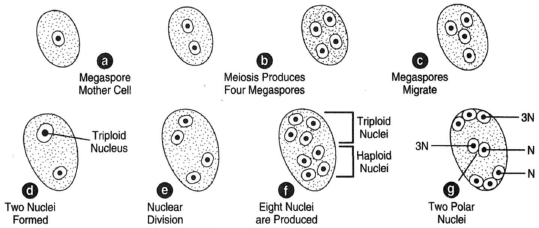Lilies
Female gametophyte development in lilies takes a different course. When the
megaspore mother cell divides to produce four megaspores, all of the megaspores
remain functional and reside within the embryo sac. Three megaspores
then migrate to the upper end, where they fuse to produce a
3N nucleus. The remaining megaspore rests at the lower end of the sac.
The remaining two nuclei undergo two mitotic divisions. The first of the
divisions increases the number of nuclei in the embryo sac to four, and the
second division increases the number to eight. Four of the nuclei are triploid,
and four are haploid. These nuclei then position themselves as described
earlier: three at the upper end (the antipodal nuclei), three at the lower end
(an egg cell and two synergids), and two in the center (the polar nuclei).
Of the two polar nuclei, one is triploid and one is haploid. Double fertilization
as earlier described then occurs. One sperm unites with the egg to
produce the zygote, a one-celled sporophyte, and the other sperm unites with
the polar nuclei to produce a 5N endosperm nucleus.
 |
| Figure 28-7 Female gametophyte development inatially. (a) Megaspore mother cell undergoes
meiosis to produce four megaspores, (b). All four megaspores remain functional.
(c) Three migrate to the upper end of the embryo sac, one to the lower end. (d) The three
at the upper end fuse, forming a triploid nucleus. There are then two nuclei. (e) They divide
twice, producing eight nuclei, four of which are triploid, and four haploid. (f) One of each
cluster of four nuclei migrates toward the center of the embryo sac to form polar nuclei (g) |





